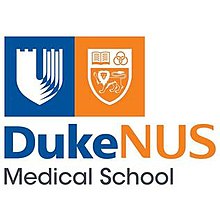Duke–NUS Medical School
.mw-parser-output .nobold{font-weight:normal} 杜克—国大医学研究生院 (Chinese) | |
 | |
| Type | Graduate school |
|---|---|
| Established | 2005 |
Parent institution | Duke University and NUS |
| Dean | Thomas M. Coffman |
| Location | Singapore |
| Website | www.duke-nus.edu.sg |
The Duke-NUS Medical School (Duke-NUS) is a medical school in Singapore. It is a collaboration between Duke University, in Durham, North Carolina, United States, and the National University of Singapore, in Singapore. The school was first set-up in 2005, and was formerly known as "Duke-NUS Graduate Medical School." Duke-NUS follows the American model of post-baccalaureate medical education, in which students begin their medical studies after earning a bachelor’s degree.
Singhealth and Duke-NUS have also come together to form the Academic Medicine Centre. The SingHealth Duke-NUS Academic Medicine Centre brings together Clinicians, Educators and Researchers, in order to bring about an improvement in patients' care.
Contents
1 Founding
2 Research
3 Doctor of Medicine program
3.1 Overview
3.2 History
3.3 Student composition
3.4 Curriculum
3.5 Teaching pedagogy
3.6 Admission grades and criteria
4 PhD program
5 MD-PhD program
6 See also
7 References
8 External links
Founding
Duke-NUS was founded in 2005, located in a transition building. Construction of Duke-NUS's primary facility, the Khoo Teck Puat Building, started in Dec 2006[1]. TOP of the building was on 20 Feb 2009. In May 2009,[2] Duke-NUS moved into the building at the Outram campus of Singapore General Hospital, right next to the College of Medicine Building. The building was officially opened by Singapore Prime Minister, Lee Hsien Loong, on 28 September 2009. The 13 storey building is green certified and was the tallest building at the Outram campus before the completion of the Academia building in 2013.
Research
Major research areas in Duke-NUS include:
- Neuroscience and Behavioral Disorders
- Emerging Infectious Diseases
- Cancer and Stem Cell Biology
- Cardiovascular and Metabolic Disorders
- Health Services and Systems Research
Under the SingHealth Academic Medicine partnership, Duke-NUS also undertakes clinical research at affiliated hospitals, clinics and specific research sites. It also supports clinical research by providing senior diseases experts and senior quantitative experts as part of mentoring teams.
Doctor of Medicine program
Overview
Duke-NUS' Doctor of Medicine (M.D.) program is a four-year program that follows the Duke University School of Medicine curriculum.[3][4] Students who successfully complete the course of study and fulfill all requirements will be awarded a joint M.D. degree from Duke University and the National University of Singapore.
History
Duke-NUS accepted its first MD students in 2007.[4] The first class of MD students graduated in 2011. Since then, over 200 students have graduated with a Doctor of Medicine degree.
Student composition
Duke-NUS accepts about 60 to 70 students in each cohort. 2/3 of the students are Singaporeans or Permanent Residents of Singapore. The rest of the students come from over 20 countries, such as Canada, China, India, Malaysia, South Korea and the U.S.. The average age of incoming medical student is 24 years old.
Curriculum
The Duke-NUS curriculum has the same structure as Duke School of Medicine:
- 1st year – Pre-clerkship
- 2nd year - Clerkship
- 3rd year – Research year
- 4th year – Advanced Clinical Rotations
Teaching pedagogy
Duke-NUS employs an extensive team-based learning method called TeamLEAD (Learn, Engage, Apply, Develop).[3] Students prepare for class with pre-reading materials and recorded lectures, They begin the class with a test. Students then proceed to discuss test questions and other open-ended questions in a small group setting. The faculty act as facilitators for student discussions, moving away from traditional pedagogical teaching.[3]
Admission grades and criteria
All applicants are required to submit their Medical College Admission Test (MCAT) scores. The mean MCAT score of the 2011 admission was 33.[4] Typically, successful applicants have entrance MCAT scores of over 30 and GPAs over 3.5. Most students admitted had at least 10 on both Physical and Biological Sciences.
Besides MCAT, the Admission Committee also evaluates applicants based on their academic performance, research experience, and evidence of leadership capabilities.
PhD program
Duke-NUS offers a PhD programme in Integrated Biology and Medicine. Students complete the following: 4 months of laboratory rotations, and research to a total of 4 – 5 years of PhD work in Singapore. The class size is currently about 15 students. Successful candidates will be awarded a PhD from both the National University of Singapore and Duke University in the USA.
MD-PhD program
Duke-NUS offers an MD-PhD programme, where students complete the following: 1 year of basic science coursework, 1 year of clinical rotations, 4 years of PhD work in Singapore, and 1 final year of clinical rotations. Successful candidates will be awarded a joint MD degree from Duke University and National University of Singapore, plus a PhD degree from the National University of Singapore.
See also
Yale-NUS, the undergraduate counterpart joint-venture at NUS
- Weill Cornell Medical College in Qatar
References
^ "Duke-NUS names its new building after late philanthropist, Tan Sri Khoo Teck Puat"..mw-parser-output cite.citation{font-style:inherit}.mw-parser-output q{quotes:"""""""'""'"}.mw-parser-output code.cs1-code{color:inherit;background:inherit;border:inherit;padding:inherit}.mw-parser-output .cs1-lock-free a{background:url("//upload.wikimedia.org/wikipedia/commons/thumb/6/65/Lock-green.svg/9px-Lock-green.svg.png")no-repeat;background-position:right .1em center}.mw-parser-output .cs1-lock-limited a,.mw-parser-output .cs1-lock-registration a{background:url("//upload.wikimedia.org/wikipedia/commons/thumb/d/d6/Lock-gray-alt-2.svg/9px-Lock-gray-alt-2.svg.png")no-repeat;background-position:right .1em center}.mw-parser-output .cs1-lock-subscription a{background:url("//upload.wikimedia.org/wikipedia/commons/thumb/a/aa/Lock-red-alt-2.svg/9px-Lock-red-alt-2.svg.png")no-repeat;background-position:right .1em center}.mw-parser-output .cs1-subscription,.mw-parser-output .cs1-registration{color:#555}.mw-parser-output .cs1-subscription span,.mw-parser-output .cs1-registration span{border-bottom:1px dotted;cursor:help}.mw-parser-output .cs1-hidden-error{display:none;font-size:100%}.mw-parser-output .cs1-visible-error{font-size:100%}.mw-parser-output .cs1-subscription,.mw-parser-output .cs1-registration,.mw-parser-output .cs1-format{font-size:95%}.mw-parser-output .cs1-kern-left,.mw-parser-output .cs1-kern-wl-left{padding-left:0.2em}.mw-parser-output .cs1-kern-right,.mw-parser-output .cs1-kern-wl-right{padding-right:0.2em}
^ name=Tony Tay
^ abc staff. "AAMC Readiness for Reform: Duke – National University of Singapore Case Study Implementing Team-Based Learning for Medical Students" (PDF). Association of American Medical Colleges. Archived from the original (PDF) on 2013-11-04. Retrieved 2013-08-01.
^ abc Kamei, Cook; Puthucheary, Starmer (2012). "21st Century Learning in Medicine: Traditional Teaching versus Team-Based Teaching". Medical Science Educator. 22 (2). Archived from the original on 2013-11-04. Retrieved 2013-08-01.
External links
- Duke-NUS Medical School Website
